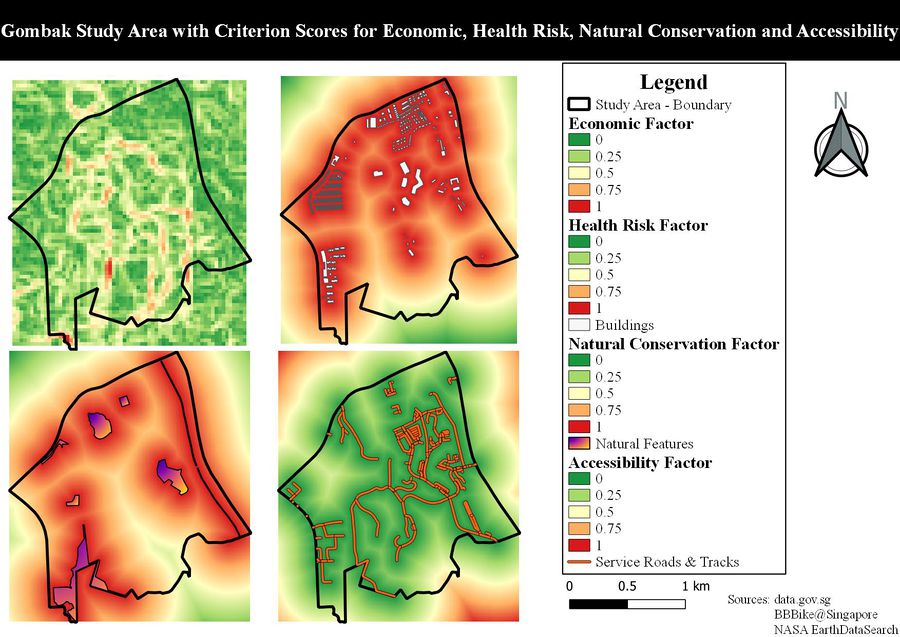From Geospatial Analytics for Urban Planning
Jump to navigation
Jump to search

Gombak Study Area with Criterion Scores of:
- Economic Factor (Top Left)
- Health Risk Factor (Top Right)
- Natural Conservation Factor (Bottom Left)
- Accessibility Factor (Bottom Right)
In order to come up with a standardized Criterion Score, we would have to ensure that the scale used across all four maps would have to be uniformed as well as the raster values of all four maps denoting the same value meaning at both ends of the scale. To further understand this better, the following was considered:
1. Necessity to Standardise a Scale to Use Across All Four Factors
- Apart from the Proximity Map of Roads, Buildings and Natural Features having different minimum and maximum values in their respective scales, the Slope Layer measures degrees as its units of measurement for its scale. Therefore, we would need to standardize the scale for the criterion score so that this scale can be applied across all four maps and thus all four factors.
2. Necessity to Invert Raster Pixel Value of Certain Map Views
- Take the Health Risk Factor (Buildings) and Accessibility Factor (Roads) for example. For the Health Risk Factor, an area would be deemed favorable if the area was located away from the buildings. In the case the Accessibility Factor, an area would be deemed favourable if the area was instead located closer to the target roads. This means that their respective scales for their own views would be opposite with each other.
From this, the following steps were carried out in the digitization of each of the views for this map:
- Normalization of all four Proximity Layers of the respective factors via the Minimum-Maximum Formula using the Raster Calculator
For Example:
 Criteria Standardization Technique: The Minimum-Maximum Formula |
| From the Slope Layer (Bottom Right), similar to the Digital Elevation - Contour Lines Map View, the degree of the land terrain of Gombak tends to increase when progressing from the North region to the South region of Gombak, in which Gombak Hill is within that proximity. From this, it is in our best interests that we do not consider the Southern areas of Gombak with high slope degrees for the suitable site for building the CQDC in terms of Economic.
|
| HEALTH RISK FACTOR (BUILDINGS)
|
| From the Slope Layer (Bottom Right), similar to the Digital Elevation - Contour Lines Map View, the degree of the land terrain of Gombak tends to increase when progressing from the North region to the South region of Gombak, in which Gombak Hill is within that proximity. From this, it is in our best interests that we do not consider the Southern areas of Gombak with high slope degrees for the suitable site for building the CQDC in terms of Economic.
|
| NATURAL CONSERVATION FACTOR (NATURAL FEATURES)
|
| From the Slope Layer (Bottom Right), similar to the Digital Elevation - Contour Lines Map View, the degree of the land terrain of Gombak tends to increase when progressing from the North region to the South region of Gombak, in which Gombak Hill is within that proximity. From this, it is in our best interests that we do not consider the Southern areas of Gombak with high slope degrees for the suitable site for building the CQDC in terms of Economic.
|
| ACCESSIBILITY FACTOR (ROADS)
|
| From the Slope Layer (Bottom Right), similar to the Digital Elevation - Contour Lines Map View, the degree of the land terrain of Gombak tends to increase when progressing from the North region to the South region of Gombak, in which Gombak Hill is within that proximity. From this, it is in our best interests that we do not consider the Southern areas of Gombak with high slope degrees for the suitable site for building the CQDC in terms of Economic.
|

